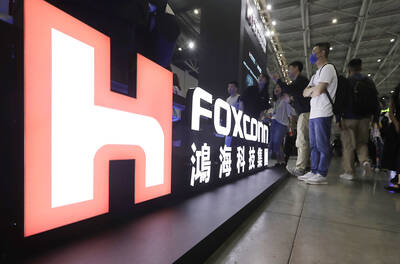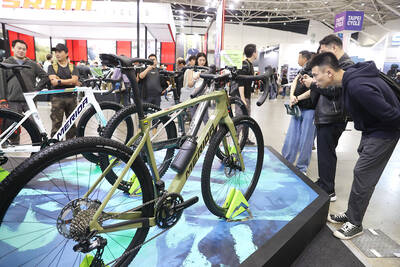Technological innovation is happening faster than people imagine. Kindle, Amazon.com’s electronic reader, serves as a clear example, as the book-size device has overturned the conventional concept of book reading.
The device was a hit among tech-savvy shoppers in the US unfazed by the severest economic recession since World War II.
Taiwanese manufacturers played a major role in Kindle’s success.
Spearheading the expansion into the fledging e-paper display and e-reader business, Taiwanese manufacturers seem well-positioned to take the lead in the market, analysts say.
“Taiwanese manufacturers are shifting away from the long-term role of earning slim profits by making electronics for other companies. They now own core component technologies that distance them from the competition abroad,” said David Chen (陳賜賢), a senior analyst at the Taipei-based Market Intelligence & Consulting Institute (MIC, 產業情報研究所).
Local panel maker Prime View Technology International Co (PVI, 元太科技), which commands a 90 percent market share, is a pioneer in the field. The company began supplying e-paper modules to e-reader vendors including Amazon.com and Sony Corp two years ago.
To cement its lead, PVI signed an agreement with e-paper display company E Ink Corp in June for a cash-and-share buyout deal worth about US$220 million.
Sipix Imaging Inc, a US-turned-Taiwanese company, is shipping e-paper display this fall, making the company the world’s second e-paper displays supplier. It also broke PVI’s dominance in the e-paper display market.
AU Optronics Corp (AUO, 友達光電), the nation’s top liquid-crystal-display (LCD) panel maker, acquired a 32 percent stake in the company for US$30 million seven months ago. AUO executives have now taken the helm at management.
E-paper displays are the main component in e-readers and account for the biggest portion — more than 30 percent — of the total manufacturing cost, Taipei-based research house Topology Research Institute (拓墣產業研究所) said.
Controlling the e-paper display manufacturing sector would help local companies gain a stronger foothold in the e-reader market, Topology analyst Harrison Po (柏德葳) said.
PVI and AUO could be two of the biggest beneficiaries from the fast-growing e-reader market, as E-Ink and Sipix outpaced rivals in commercially launching e-paper displays two years ago and this year respectively, Chen said.
While potential rivals such as Japan’s Bridgestone Corp and Fujitsu have showcased prototypes of e-paper displays, it might be at least a year before they catch up with E Ink and Sipix, as they have yet to overcome technological problems such as poor resolution and slow refresh time, Chen said.
Last year, Taiwanese electronic power supply maker Delta Electronics Inc (台達電) exhibited the first-generation of e-paper displays using Bridgestone technology during the IFA consumer trade show in Berlin, but no commercial product has been seen yet.
As early players, local firms are pinning hopes on emerging e-reader business to breathe new life into their operations.
AUO said it aimed to enhance profitability and create a buffer against the volatile LCD industry by diversifying into new green businesses — including e-readers and solar cell industries — to compete with bigger South Korean rivals LG Display Ltd Co and Samsung Electronics Co, whose strong brand businesses have helped them handle industrial troughs more effectively than panel makers.
“We hope the new business will add value to AUO,” Chen Lai-juh (陳來助), president of AUO, the world’s No. 3 liquid-crystal-display (LCD) panel market, told investors.
“The e-paper and e-reader market as a whole is much bigger than you would imagine,” Chen said.
Shipments of e-readers are expected to grow at a compound annual growth rate of 78.2 percent to 19.76 million units over the next five years to 2013, a conservative forecast by MIC showed. This year, shipments could triple to 3.05 million units, from last year’s 1.1 million units, the researcher said.
AUO, which assembles e-paper modules, last month began shipping products to customers including Qisda, which is scheduled to launch BenQ brand e-readers by the end of this year.
Meeting growing demandwill be a difficult task.
“Quickly boosting capacity to match customer demand is challenging,” Sipix president Andrew Tseng (曾旭平) said.
Sipix intends to increase its monthly capacity nine-fold to 3 million 6-inch units by the end of next year, from 300,000 units at present.
To resolve glass capacity limitations, PVI signed a memorandum of understanding with Chi Mei Optoelectronics Corp (奇美電子) to supply glasses, which are used to buffer electronic ink and integrated circuits.
Taiwanese electronics makers will be natural partners for companies seeking to enter the e-reader market.
Hon Hai Precision Industries Inc (鴻海精密) is reportedly making e-readers for Amazon.com and Sony.
A little more than three years ago, Netronix Inc (振曜) started making e-readers at its factories, but a high technological barrier did not make the new business its major revenue source — at least not until it formed a partnership with PVI two years ago.
Targeting bookstore chains and telecom operators, Netronix now makes half of its revenues from e-readers.
A growing number of companies are preparing to enter the e-reader market, including notebook computer makers such as Asustek Computer Inc (華碩電腦), which made the world’s first netbook, as well as Inventec Inc (英業達), the nation’s No. 4 contract notebook maker.
Inventec is reported to have received orders for e-readers from the US’ biggest bookstore chain, Barnes & Noble.
“In Taiwan, a full e-reader supply chain is emerging, allowing Taiwanese companies to take a central position in the business,” Po said.
Also See: Google sparks e-book battle with Kindle

A proposed 100 percent tariff on chip imports announced by US President Donald Trump could shift more of Taiwan’s semiconductor production overseas, a Taiwan Institute of Economic Research (TIER) researcher said yesterday. Trump’s tariff policy will accelerate the global semiconductor industry’s pace to establish roots in the US, leading to higher supply chain costs and ultimately raising prices of consumer electronics and creating uncertainty for future market demand, Arisa Liu (劉佩真) at the institute’s Taiwan Industry Economics Database said in a telephone interview. Trump’s move signals his intention to "restore the glory of the US semiconductor industry," Liu noted, saying that

On Ireland’s blustery western seaboard, researchers are gleefully flying giant kites — not for fun, but in the hope of generating renewable electricity and sparking a “revolution” in wind energy. “We use a kite to capture the wind and a generator at the bottom of it that captures the power,” said Padraic Doherty of Kitepower, the Dutch firm behind the venture. At its test site in operation since September 2023 near the small town of Bangor Erris, the team transports the vast 60-square-meter kite from a hangar across the lunar-like bogland to a generator. The kite is then attached by a

Foxconn Technology Co (鴻準精密), a metal casing supplier owned by Hon Hai Precision Industry Co (鴻海精密), yesterday announced plans to invest US$1 billion in the US over the next decade as part of its business transformation strategy. The Apple Inc supplier said in a statement that its board approved the investment on Thursday, as part of a transformation strategy focused on precision mold development, smart manufacturing, robotics and advanced automation. The strategy would have a strong emphasis on artificial intelligence (AI), the company added. The company said it aims to build a flexible, intelligent production ecosystem to boost competitiveness and sustainability. Foxconn

Leading Taiwanese bicycle brands Giant Manufacturing Co (巨大機械) and Merida Industry Co (美利達工業) on Sunday said that they have adopted measures to mitigate the impact of the tariff policies of US President Donald Trump’s administration. The US announced at the beginning of this month that it would impose a 20 percent tariff on imported goods made in Taiwan, effective on Thursday last week. The tariff would be added to other pre-existing most-favored-nation duties and industry-specific trade remedy levy, which would bring the overall tariff on Taiwan-made bicycles to between 25.5 percent and 31 percent. However, Giant did not seem too perturbed by the